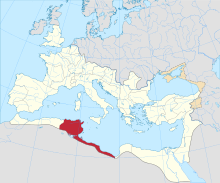
Byzacena was a Late Roman province in the central part of Roman North Africa, which is now roughly Tunisia, split off from Africa Proconsularis.

Téboursouk is a town and commune in the Béja Governorate, Tunisia. It is located at 36° 27′ 26″N, 009° 14′ 54″E.
Jebiniana is a town and commune in the Sfax Governorate, Tunisia.
Sidi El Hani is a town and commune in the Sousse Governorate, Tunisia located at 35.67n, 10.30e. As of 2004 it had a population of 3,058. It gives its name to the largest lake of the governorate, a natural salt lake or salt pan (sabkha) in dry seasons, the Sebkhet de Sidi El Hani which is shared with between one and two other areas depending on precipitation and its maximum extent forms the official boundary with part of a third, Monastir Governorate. The town is 30 km south-west of the coast, its straightest connection being by Tunisian Railways, with a secondary connection by road, the P12 road which is a principal road to Kairouan from the A1 a few kilometres to the east. it is 19 km from Kairouan and 26 km from Raqqada.

Simminensis is an ancient and titular episcopal see of the Roman province of Africa Proconsularis in modern Tunisia, and a suffragan diocese of the Archdiocese of Carthage.
Henchir-Tebel is a town and archaeological site in Al Qayrawān, Tunisia, near Kairouan

Henchir-El-Hatba is a village and an archaeological site in Tunisia. It was a Roman Catholic diocese.

Abbir Maius also known as Abbiritanus was a Roman and Byzantine-era civitas (city), later municipium, in the Roman province of Africa proconsularis.

Abthugni was an ancient city in Roman North Africa at present day Suwar (Henchir-es-Souar) in Tunisia. It was, in Roman times, in the province of Africa Proconsularis, Africa, and latter in Byzacena. In late antiquity Abthugni was also the seat of a bishop, and the diocese is a titular see of the Roman Catholic Church to this day.

Sutunura was a Roman era civitas in the Roman province of Africa and is tentatively identified with ruins near Aïn-El-Askerm, Rdir-Es-Soltan in modern Tunisia.(36° 34' 29" North, 9°59'29"East) 50 km from Carthage. The location being confirmed with inscription remains in situ and is nearby to Koudiat es Somra, Jebel Barrou and Ghedir Soltane.

Henchir Bez is an archaeological site in Tunisia, located at 36° 00′ 23″ N, 9° 32 in the hills overlooking the Oued Miliane river, west of Tunis. Identified by a recently discovered inscription, it is the ruins of the Roman civitas of Vazi Sarra, which include a Christian Basilica and a Byzantine/Roman fort.
Crich El Oued, also known as Qarish el-Wadi, is a village in Tunisia, located between Bordj Toumi and Majaz al Bab in Béja Governorate east of Tunis. The village is on the Medjerda river at the confluence with the Oued el-Ahmar and the town has a mosque

Henchir-El-Msaadine is a Roman era set of ruins near Tebourba(Ancient Thuburbo Minus) in modern Tunisia, North Africa. The site is outside of Tunis. The ruins are tentatively identified as the remains of Municipium Aurelium Antoninianum Furnitanorum also known as Furnos Minor, a city of Africa Proconsularis. Furnos Minus had the rank of a Municipium (city) of Africa Proconsularis and has been identified through Epigraphic remains
Henchir-Boucha is a former Catholic diocese and archaeological site in Tunisia.

Henchir-Aïn-Dourat, also known as Ad-Duwayrat or Henchir Durat, is a former Roman–Berber civitas and archaeological site in Tunisia. It is located at 36.767496n, 9.524142e, in the hills just north of Toukabeur and 15.3 km from Majāz al Bāb. It was an ancient Catholic diocese.
Henchir-El-Meden is a locality and archaeological site in Tunisia.

Gunela was an ancient Roman-Berber town and archaeological site in Bizerte Governorate, Tunisia. It was located at 37.165524n, 9.765536e, within the suburbs of Tinja, Tunisia.
Henchir-Khachoum is a locality and series of archaeological sites in Sidi Bouzid Governorate modern Tunisia. The ruins are strewn along a tributary of the Oued El Hatech river east of Sbeitla. During the Roman Empire there was a Roman town of the Roman province of Africa Proconsularis, called Muzuca, one of two North African towns to bare that name.

Henchir-Sidi-Salah is a rural locality and archaeological site in the hinterland behind Sfax, Tunisia.

Muzuca was a Roman Town of the Roman province of Byzacena during late antiquity. The town has tentatively been identified with the ruins at Henchir-Besra in modern Tunisia. Very little is known of the city, though in situ epigraphical evidence gives us the name and that in late antiquity it achieved the status of Municipium.









